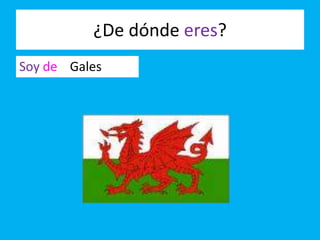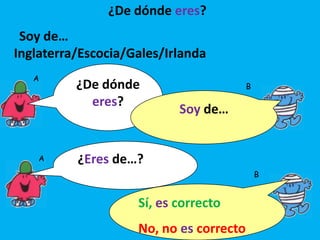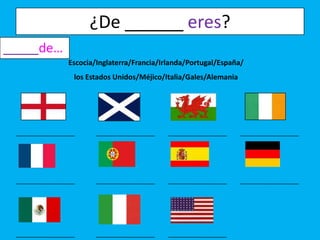Using target language in the classroom ililc3
- 1. Using Target Language in the Classroom #ililc3 Samantha Lunn @spanishsam All examples will be in Spanish or French
- 2. Qu’est-ce que nous allons faire?
- 3. Qu’est-ce que nous allons f**** aujourd’hui? Je pense que… Nous allons p*rler en ang**** Nous allons p*rler en fr****** Nous allons éc**ter d* l* m*s*que Nous allons ch*nter Nous allons l*re Nous allons *crire Nous allons f**re un t*st 10/10 Nous allons r*c*v*ir l*s d*v*irs Nous allons p*rler d*s activités utiles pour la salle de classe
- 4. Objectives: By the end of the session you will: • see different techniques that you can employ in the classroom to encourage the use of the target language immediately • know how to embed in your teaching a series of routines and activities that can lead to deeper use of the target language
- 5. Key ingredients • Expectations • Develop and build • Routines • Songs • Encourage TL use – praise/reward • Pupil Interaction Language • Introducing language for the first time • Scaffold language
- 6. Expectations • Set expectations • Use English • Comment dit-on en français/anglais? • ¿Cómo se dice en español/inglés? • Embed these key phrases!
- 7. Vamos a cantar ¿Cómo se dice blah blah blah en español? ¿Cómo se dice blah blah blah en español? ¿Cómo se dice en inglés? ¿Cómo se dice en inglés? ¿Cómo se dice blah blah blah en español?
- 8. Expectations • Ask for permission for various things e.g. to speak in English, go to toilet, take jacket off • Est-ce que je peux parler en anglais? • ¿Puedo hablar en inglés? • Build, develop, insist!
- 9. Vamos a cantar ¿Puedo quitarme la chaqueta por favor? ¿Puedo hablar en inglés por favor? Necesito un boli Necesito papel Necesito ir al baño por favor
- 10. Routines • Anything can be a routine! • My repertoire includes: – Objective setting – Asking for different things – Register – Team points – Forfeits – Homework setting – Setting up pairwork activities – Mimes and actions
- 11. Vamos a cantar ¿Puedo ser voluntario/a, por favor? ¿Puedo cronometrar, por favor? ¿Puedo pasar lista, puedo cronometrar?, ¿Puedo ser voluntario/a, por favor?
- 12. Vamos a cantar ¿Cómo se dice blah blah blah en español? ¿Cómo se dice blah blah blah en español? ¿Cómo se dice en inglés? ¿Cómo se dice en inglés? ¿Cómo se dice blah blah blah en español? ¿Puedo quitarme la chaqueta por favor? ¿Puedo hablar en inglés por favor? Necesito un boli Necesito papel Necesito ir al baño por favor ¿Puedo ser voluntario/a, por favor? ¿Puedo cronometrar, por favor? ¿Puedo pasar lista, puedo cronometrar?, ¿Puedo ser voluntario/a, por favor?
- 13. No se¡Oh no! debe hablar Tienes que hacer ¡_____ ha hablado en inglés. Está una prenda. prohibido. en inglés!
- 14. Tengo que no se debe hablar en inglés, pero ____ Tenemos que Tienes que hablado Tenéis que has en inglés entonces tienes que (…) 1,2,3 ¡ya! Tiene que Tienen que 1-30 1 decir (5) veces “me 2 saltar (5) veces 3 contar hasta (?) encanta el español” a,b,c… ir ser 4 5 conjugar el verbo 6 conjugar el verbo decir el alfabeto “ir” “ser”
- 17. LOS DEBERES
- 18. Encourage TL Use • Create ‘real’ opportunities for pupils to use TL • Deal with the unknown/unexpected • Praise verbally and physically • Ensure there is a reason for pupils to want to use it – challenge! • Team points – Ask for points (singular and plural) – Develop reasons why – Ask for class to agree or not and give reasons • Pupil interaction language posters/cheat sheets/stick-ins
- 19. Introducing Language • Always use a question when teaching new language (context) • Introduce small chunks at a time using the answer structure • Use short, sharp games to recap and drill language after each chunk • Set up pairworks for pupils to practise each chunk with each other (model this first) • Pairworks: mime and guess, draw in air and guess, mumble and guess, draw on hand and guess, mime super fast/slow • Scaffold pupil-pupil language so they know exactly what to say
- 20. ¿Qué vamos a estudiar?
- 22. Vamos ¿Qué vamos a estudiar las a estudiar? nacionalidades
- 23. ¿De dónde eres? Soy de Inglaterra
- 24. ¿De dónde eres? Soy de Escocia
- 25. ¿De dónde eres? Soy de Gales
- 26. ¿De dónde eres? Soy de Irlanda
- 27. ¿De dónde eres? Soy de
- 28. ¿De dónde eres? Soy de… Inglaterra/Escocia/Gales/Irlanda A ¿De dónde B eres? Soy de… A ¿Eres de…? B Sí, es correcto No, no es correcto
- 29. ¿De dónde eres? Soy de Francia
- 30. ¿De dónde eres? Soy de Portugal
- 31. ¿De dónde eres? Soy de España
- 32. ¿De dónde eres? Soy de Alemania
- 33. ¿De dónde eres? Soy de
- 34. ¿De dónde eres? Soy de… Inglaterra/Escocia/Gales/Irlanda/Francia/Portugal/España/Alemania A ¿De dónde B eres? Soy de… A ¿Eres de…? B Sí, es correcto No, no es correcto
- 35. ¿De dónde eres? Soy de Méjico
- 36. ¿De dónde eres? Soy de Italia
- 37. ¿De dónde eres? Soy de los Estados Unidos
- 38. ¿De dónde eres? Soy de
- 39. ¿De dónde eres? Soy de… Inglaterra/Escocia/Gales/Irlanda/Francia/Portugal/España/Alemania/ Méjico/Italia/ los Estados Unidos B A ¿De dónde eres? Soy de… A ¿Eres de…? B Sí, es correcto No, no es correcto
- 40. ¿De dónde eres? Soy de
- 41. ¿De dónde eres? Soy de
- 42. viernes, 15 de febrero de 2013 ¿De dónde eres? Soy de Ingl_t_rr_ Inglaterra Esc_c_ _ Escocia G_l_s Gales _rl_nd_ Irlanda Fr_nc_ _ Francia P_rt_g_l Portugal _sp_ñ_ España _l_m_n_ _ Alemania Méj_c_ Méjico _t_l_ _ Italia l_s Est_d_s Un_d_s los Estados Unidos
- 43. ¿De ______ eres? _____de… Escocia/Inglaterra/Francia/Irlanda/Portugal/España/ los Estados Unidos/Méjico/Italia/Gales/Alemania
- 44. Benefits Developing pupils’ spontaneous language SOLO: Multi-structional Develops tenses and opinions/reasons Develops speaking and listening skills
- 45. Summary • Routines • TL environment • Posters/Displays • Pupil using TL! • Give it a try! @spanishsam www.languagesresources.wordpress.com
Notas del editor
- Song to the tune of “She´ll be coming round the mountain”
- Song to the tune of “She´ll be coming round the mountain”
- Song to the tune of “She´ll be coming round the mountain”
- Song to the tune of “She´ll be coming round the mountain”
- Mumble and guess
- Mumble and guess
- Mumble and guess













































